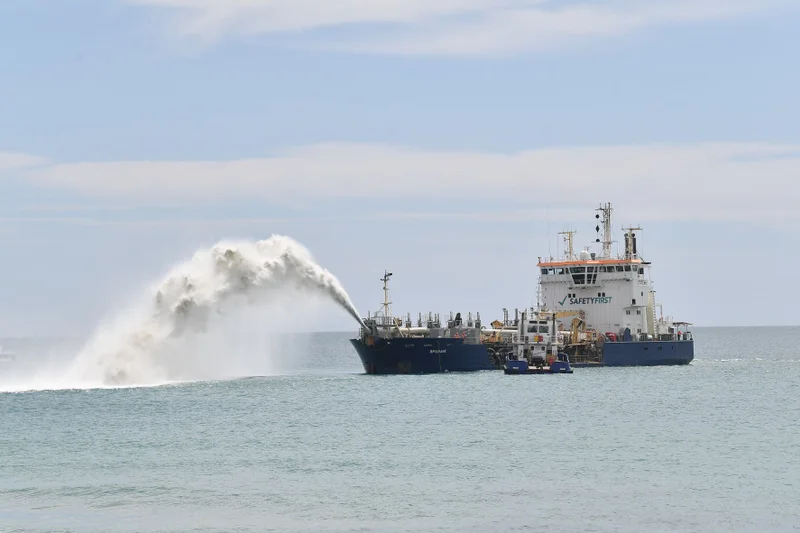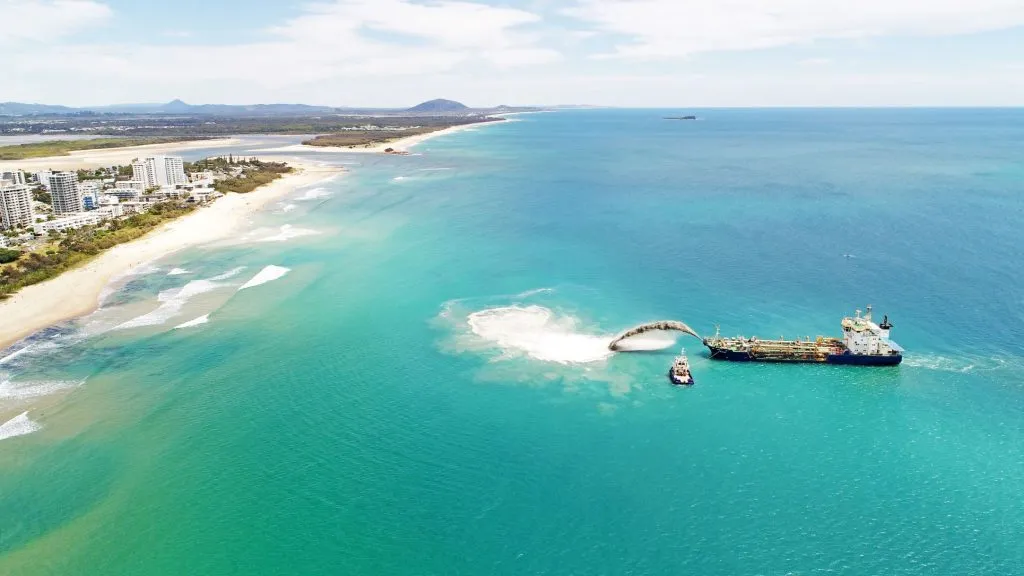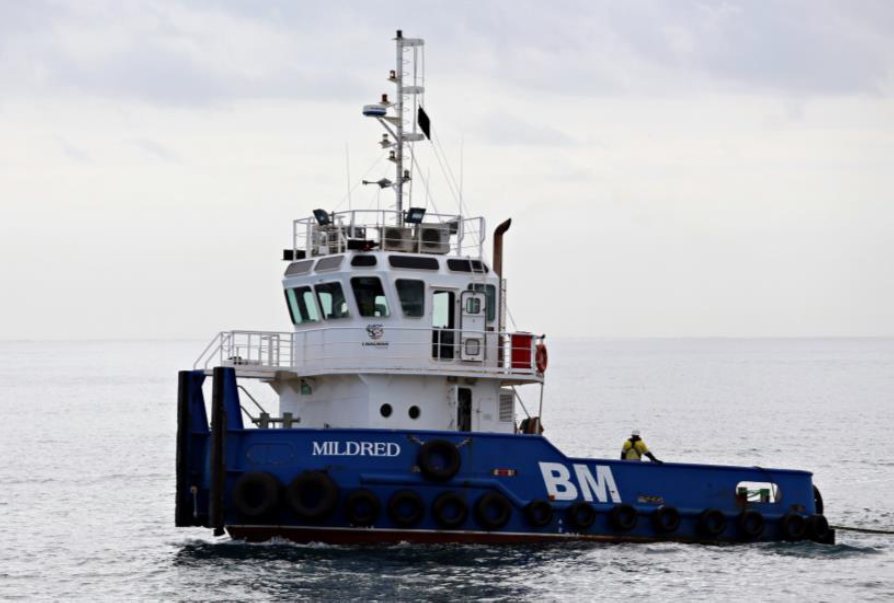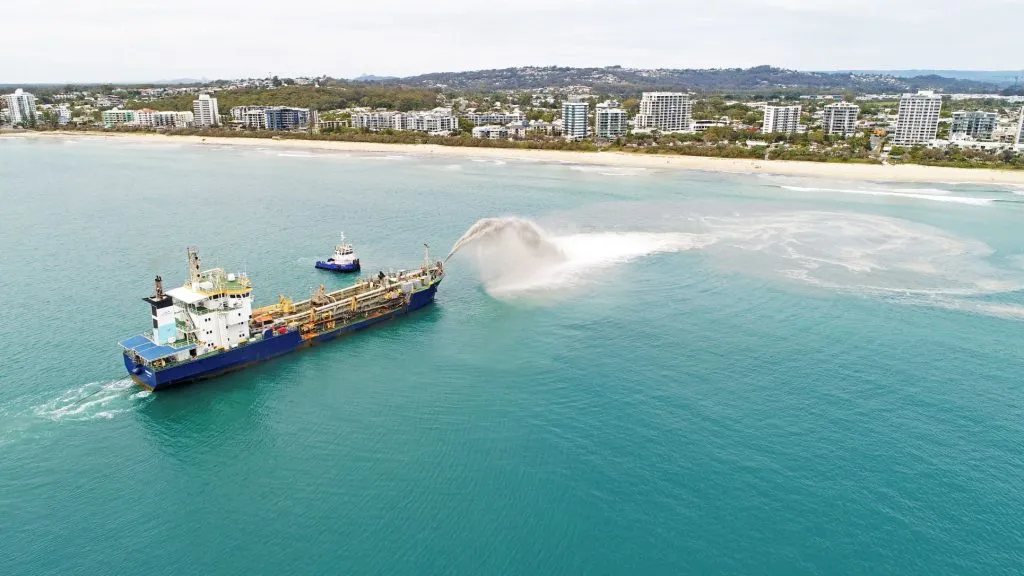Unusual vessel cruises in for beach-boosting trial

A distinctive vessel has arrived in Sunshine Coast waters to play a leading role in a special trial aimed at replenishing a popular beach.
It’s called TSHD Brisbane and the TSHD stands for Trailing Suction Hopper Dredger.
Such vessels can collect sand from the seabed and transport it over large distances for use elsewhere.
This hopper dredger will travel from the Spitfire Channel, in Moreton Bay, to Maroochydore Beach carrying sand.
As part of the Maroochydore Beach Nearshore Nourishment trial, expected to run from November 16 to 24 (weather permitting), it will place sand just offshore by “rainbowing’’ or by bottom placement.

TSHD Brisbane and support vessel Mildred in action rainbowing at Maroochydore Beach
Rainbowing is when sand is mixed with water and sprayed from the ship’s bow in a huge arc, like a rainbow.
Bottom placement is when sand is released from the bottom of the hull in a grid like pattern.
Sunshine Coast Council’s Environment Portfolio Councillor Peter Cox said community safety was council’s top priority throughout the trial.
“Strict safety measures will be in place on the beach and in the water for our community’s safety – and the support vessel “Mildred” as well as lifeguards on jet skis, will help with those measures by keeping the water clear before, during and after the dredge operates,” Cr Cox said.

Support vessel Mildred
“It takes roughly 7.5 hours for the barge to travel to Moreton Bay and back again, and over the course of the week it will make the trip 21 times, weather dependent, and be working 24 hours a day.
“Please follow lifeguard instructions and stay clear of the area the dredge operates in before it arrives, during the placement and after it has left.”
An exclusion zone will be in place in the water and on the beach to keep everyone safe and so the dredge can do its job.
The exclusion zone will be in force after the dredge has left so the water can settle and be safe for water users.
Shark nets within the exclusion zone will be temporarily relocated 80 metres from their original location while the works are being conducted.
Council’s Principal Coastal Engineer Georgia Keeshan said the volume of sand being transported was 40,000m3 or equivalent to about 4000 10-metre tipper truck loads.
“This is a small amount compared to most beach nourishment operations. It’s been kept low on purpose to be able to evaluate if we are achieving our goals.
“We aim to understand if the science is correct and if the technique is viable for placing larger quantities of sand in the future if needed; if there’s anything we’d need to change from an operational perspective; and our community’s views on the technique.

“After the nourishment operations have finished, we will monitor the impacts on marine plants and the reef with divers; the sand movement over time with hydrographic surveys and cameras; the impacts to surf amenity through the University of the Sunshine Coast; and community sentiment on the technique.
“We will share the outcomes of the trial when results become available.”
Cr Cox said the best views will be from the shoreline, outside the exclusion zone.
“Rainbowing will be the most interesting technique visually,” Cr Cox said.
“We expect the dredge to rainbow sand first up in the morning, between 6 to 9am, when the wind is low – and this is all weather dependent.

TSHD Brisbane and the TSHD stands for Trailing Suction Hopper Dredger
“During the other trips it will be releasing the sand from its hull, which you won’t be able to see.
“The dredge will place the sand about 300m off the beach and then nature should put it back onto the beach.
“I encourage the community to let us know their views on the trial at haveyoursay.sunshinecoast.qld.gov.au.”
All necessary environmental approvals are in place.
For answers to frequently asked questions about the trial, please visit council’s website.
For further information about the location of Shark Control Program equipment please visit https://www.daf.qld.gov.au/sharksmart/map.
*Large Truck - 10mtr Tipper carrying capacity approximately 8-10 cubic metres (up to 12.5 tonne).
Last edited on:
First published on: